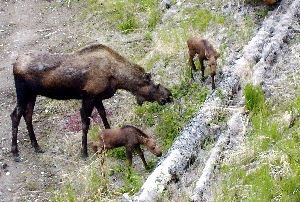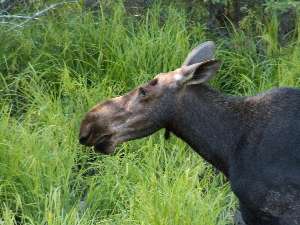Concerns Caused by Supporting Moose Populations
Although the public largely supports the efforts to reintroduce moose in the Adirondacks, there are still negative factors that need to be considered and addressed as this species' population grows. Concerns about moose reintroduction revolve mainly around interactions between moose and humans, particularly as tourism increases in the park. These concerns are particularly relevant to the Adirondacks because the park is divided into public and private land, making it likely for a moose to accidentally wander into residential areas.

Moose are not normally aggressive, but may become irritated in the winter when they are hungry, tired, or harassed by people or other animals. They can also become aggressive during the fall mating season, or late spring, when females are protective of their young ("What to Do About Aggressive Moose" 2). If provoked under these conditions, moose may react by kicking and charging at people. In response to this potential aggression, the State of New York has developed a "Moose Response Manual" which "provides local law enforcement authorities with information on appropriate actions to take if a moose is reported in their community" ("Moose Management" 4). Moose have been known to wander into residential areas in the Adirondacks, so this guide includes details on how to deal with various scenarios, such as sick or injured moose, moose calves separated from a mother, moose in urban areas andaggressive moose. Occasionally moose must be relocated when they appear in an urban area, but this process risks injuring the animal so is only attempted when there is no alternative ("Moose Management" 4).

In addition to concerns over the potential danger of stressed moose, humans are also concerned by the tendency for moose to damage agricultural crops, private property, harm livestock and disturb regenerating forests ("Moose Management" 5). In Canada, moose population has risen to a pointwhere moose are considered pests. Moose graze on young forests and have caused significant damage to balsam fir and white birch forests (Bergerud and Manuel 2). However, in this circumstance, scientists recorded a minimum of 12 moose per square mile (Bergerud and Manuel 2). Scientists estimate that there are between 1 and 2 moose per square mile in the Adirondacks, which is nowhere close to the population in Canada ("Moose" 7). Moosedamage to forests and agriculture in the Adirondacks maybe a risk in the future, but the low populationdensity indicates that it does not posean immediate threat.
_______________________________________________________________________________________________________
Sources Cited
Bergerud, Arthur T., and Frank Manuel. "Moose Damage to Balsam Fir-White Birch
"Cow Moose with Two Calves." Wikipedia Commons. Wikipedia, 31 May 2009. Web. 11
May 2015.
"Elch." Wikipedia Commons. Wikipedia, 27 July 2005. Web. 11 May 2015.
Forests in Central Newfoundland." The Journal of Wildlife Management 32.4 (1968): n. pag. Print.
"Moose." State University of New York, College of Environmental Science and Forestry. N.p., 1988. Web. 5 Apr. 2015.
"Moose Management." New York State Department of Environmental Conservation. N.p., n.d. Web. 5 Apr. 2015.
"What to Do About Aggressive Moose." Alaska Department of Fish and Game. N.p., 2015. Web. 5 Apr. 2015.
